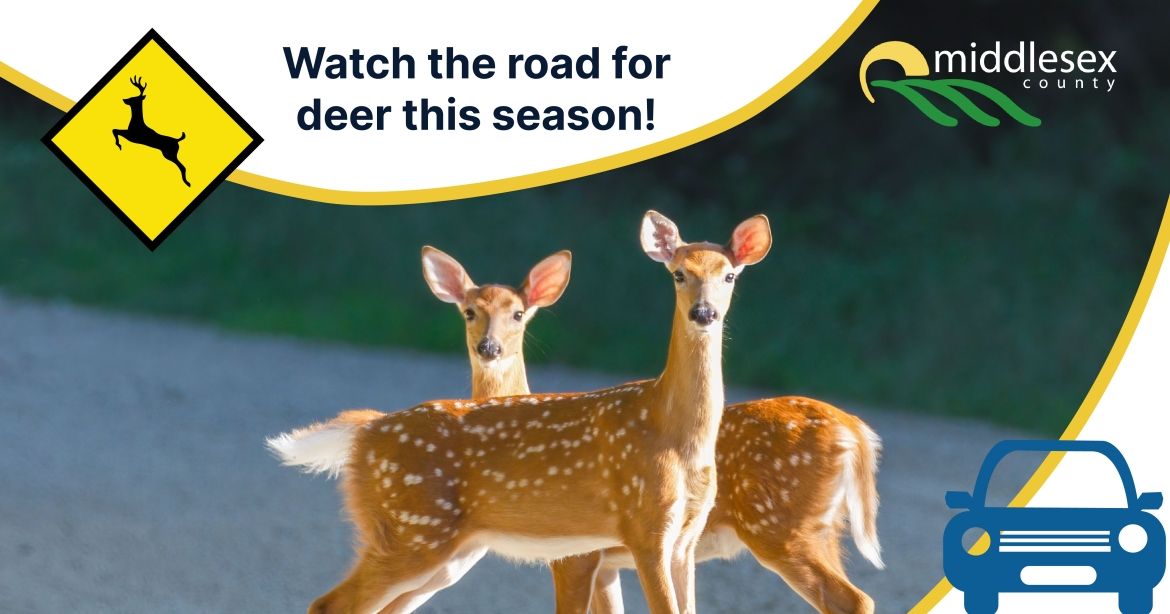
The term 'rut' is the mating season for certain mammals. From October to November, the Middlesex OPP sees the most collisions with deer, usually in the early morning or dusk timeframes, although they can occur anytime. Below are some tips from Work Place Safety North on how to drive safely, especially around deer appearing more often this time of year.
How Can Drivers Reduce the Chances of Having a Wildlife Vehicle Collision?
1. Watch for the Signs
A Wildlife Warning Sign is a yellow diamond-shaped sign. The sign warns advises drivers to be alert and cautious of any deer who are near or cross the road. Drivers must obey wildlife warning signs and any associated speed changes.
2. Reduce Speed
Speed is one of the most common factors in vehicle collisions. Speed:
- Reduces the driver's ability to steer away from objects in the roadway
- Extends the distance required to stop
- Increases the force of impact, in the event of a collision
By maintaining the posted speed, drivers can compensate for increased risk.
3. Think "What If...?"
Mental preparation is a useful tool. Think about the landscape that you are driving through. Is it a good habitat for wildlife? Predict what you might do if an animal suddenly darted out in front of you or ran towards your vehicle. It is better to think about and learn how to avoid an encounter with wildlife than to react to a dangerous situation when you are unprepared.
4. Drive Defensively
Drivers and passengers should actively watch for:
- Wildlife - on the road, in the ditch, on the shoulder, and in the right of way
- Movement on or alongside the road
- Shining eyes, which will be your headlights reflecting off the animal's eyes
- Flickering headlights of oncoming cars or tail lights of the vehicles in front of you - which may be an animal crossing the road
- Roadside reflectors that disappear/reappear, which might indicate an animal crossing in front of them
- Watch out between dusk and dawn. Light levels are low and animals are more active during these times of day
5. To Swerve or Not to Swerve?
If deer are in your way - think carefully. Is it safe to swerve?
Do not take unsafe evasive actions. Serious accidents can occur when drivers lose control of their vehicles trying to avoid an animal. Always reduce your speed in signed areas. Driving at a slower speed may mean it is not necessary to swerve at all. Swerving can take you into the path of an oncoming vehicle or into the ditch.
6. Use Your Vehicle
- Wear your seatbelt at all times
- Maintain your vehicle - Keep headlights, signal lights, and tail lights clean and in good working order
- Keep headlights properly aligned to avoid blinding other drivers and optimize road coverage. Keep your headlights clear of dirt and road salt residue
- Use high beams when it is safe to do so, and scan the road ahead with quick glances
- Honk your horn or flash your lights to scare animals off the road. This may scare a deer off the road
- In a 3-lane situation, when it is safe to do so, and when it is not impeding other traffic, drive in the middle lane to provide more distance from the ditch
- Think about getting an "Electronic Stability Control" system for your vehicle
What Should Drivers do if They See Wildlife on the Road?
- Slow Down - collision avoidance and driver response time are improved at slower speeds
- Anticipate unpredictable behaviour from all wildlife
- Determine what the animal is doing and where it is going
- Some animals travel in groups - where there is one animal, there may be more. Watch for doe/fawn or moose cow/calf pairs
For more information and resources, please visit Workplace Safety North.
